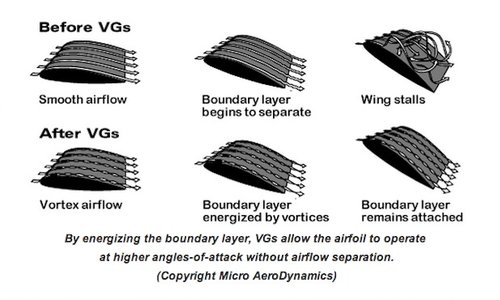Page 1 of 1
vortex generators - tested video
Posted: Sun Dec 29, 2013 12:17 pm
by Turbo
Re: vortex generators - tested video
Posted: Sun Dec 29, 2013 5:21 pm
by John.com
Thanks Turbo!!
For most of us, understanding how 'disrupting' the laminar airflow can ASSIST WITH low-end airflow and stalling parameters is quite hard to grasp.

For those 'new' to VGs, here is some simple theory and a nice diagram, courtesy of
AVWeb.com:
Near the leading edge of the wing, the boundary layer is very thin, and the air molecules in it move smoothly and parallel to the wing surface. This is known as laminar flow. But as the airflow progresses aft from the leading edge, the boundary layer becomes progressively thicker and more unstable, and transitions to turbulent flow in which intermixing of faster and slower air molecules starts to take place. (Another easily-seen example of laminar and turbulent flow can be seen by watching the smoke rise from a lighted cigarette in a draft-free room.)
[attachment=0]VGs - Cigarette Smoke.png[/attachment]
It turns out that laminar flow is a good-news/bad-news situation. The good news is that laminar flow provides greatly reduced drag compared to turbulent flow. The bad news is that laminar flow permits the boundary layer to separate easily from the wing surface at high angles of attack. That's why so-called "laminar flow airfoils" (which are designed to move the transition to turbulent flow further aft) tend to provide low drag at cruise but nasty stall characteristics.
Turbulent flow in the boundary layer produces more drag, but is much more resistant to separation (and therefore to stalling). However, even in areas of turbulent flow, there tends to be a thin sub-layer of laminar flow in the immediate vicinity of the wing surface which becomes increasingly slow-moving and stagnant toward the trailing edge of the wing. It is this "aerodynamically dead" sub-layer that allows airflow to separate and the wing to stall.
If we could find a way to energize this sublayer, flow separation would be supressed and the onset of stall delayed. This is precisely what vortex generators do. Each VG creates a pencil-thin tornado-like cone of swirling air that stimulates and organizes the turbulent flow of the boundary layer on the aft portion of the wing. The swirl of the vortices pull fast-moving air down through the boundary layer into close proximity to the wing surface, energizing the previously-dead air there. The result is a wing that can fly at significantly higher angles of attack before the onset of boundary layer separation, and can therefore achieve a significantly higher maximum lift coefficient.
When mounted on the wings, VGs reduce stall speed and increase climb capability. When mounted on the vertical tail, they increase rudder effectiveness and lower Vmc.

If you want to get much more theoretical, visit
Stolspeed.com 